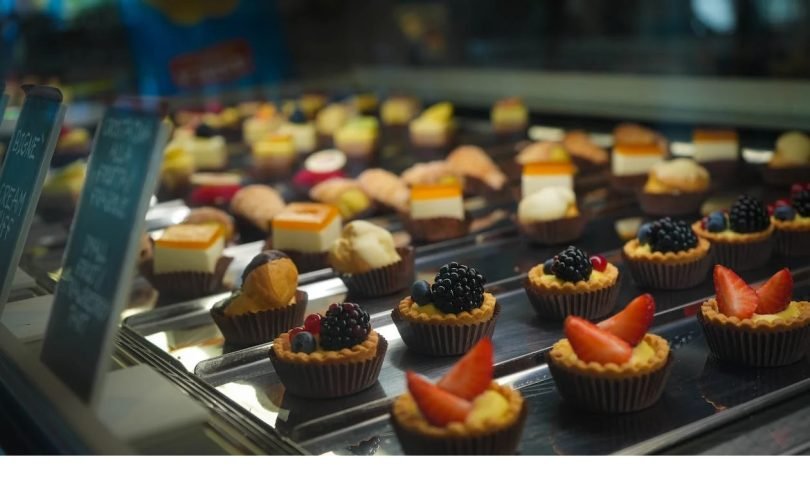Introduction
The first cakes that humans made were just a simple mixture of flour, milk, and sugar that were made around 7000 years ago. By way of cooking, they were dried on stones facing the sun. Real pastries appeared in antiquity, when people started adding various ingredients to biscuit and bread preparations. The Greeks give the first name to a cake “Obelias”, which means “offering”.
Four centuries BC the first corporation called “Pastillariorum” appeared in Rome. The term “Pastel” which means cake in Roman comes from the Greek word “pasté” and which designates a mixture of flour with a liquid. Roman pastry was not as varied as Greek.
The Arab influence, and more precisely of the Persians, is largely underestimated. The two important techniques left by the Arabs are: sugar work and puff pastry.
The cultivation of sugar cane begins in Persia, to extend later to Syria and Egypt in the 7th century. Arab doctors mastered the cooking of sugar, for them jams, dragees, fruit jellies or syrups were medicines before being confectionery. In the 7th century, the Arab conquest made sugar known throughout the world. The first stacking of dough, the ancestor of puff pastry, was used in the manufacture of traditional cakes (baklava) of the Ottoman Empire in the 13th century. Puff pastry is a French invention.
The evolution of pastry in France:
- Middle Ages
In the 13th century appearance of the guild of pastry chefs at this time they are called “oublayeurs”, they invented a pastry called “oublie”. In the 16th century the title “master of the art of pastry chef” was given to pastry chefs by King Charles IX. The French Revolution in 1771 put an end to the guild. And we have to wait until 1906, for the creation of the National Pastry Confederation.
- The Renaissance
The use of new products from the modern era, such as chocolate and coffee, made the Renaissance the golden age of pastry in France.
France experienced a real pastry boom from the end of the 17th century to the beginning of the 18th century because of:
– The discovery of sugar in France was in the second half of the 17th century, before that, the honey was used, therefore pastry was limited.
– A revolution that occurs in the 18th century and will support pastry-making is the introduction of the menu, which will start with salty and end with sweet.
* In 1533 the future King Henry II married the future Queen of France Catherine de Medicis, she made known the macaroons, the ice cream, the madeleines at the French court, because she brought with her her Italian pastry maker Popelini.
* In 1615 the court discovered chocolate, which arrived in the luggage of two queens. First the wife of King Louis XIII Anne of Austria and then his niece Marie Thérèse of Austria who married King Louis XIV.
* The master pastry chef Ragueneau in 1638 invented almond tartlets.
* In 1661, François Vatel, a celebrated chef, invented the amours whipped cream served at the « Château de Chantilly » at royal banquets. The same year, Madeleine Simonin created madeleines. The invention of refrigeration and canning dates back to the 18th century.
*Marie-Antoine Carême was a pastry chef and chef born in Paris (1784-1833), the real promoter of French pastry, we owe him several creations: meringues, poupelins, vol-au-vent, crunchy , nougat. He will create « piéces montées » that will reach several feet in height inspired by temples, pyramids and ancient ruins. It will perfect puff pastry, and lady finger biscuits. Carême is the author of several books: the best known of which is “The Art of French Cuisine in the 19th Century”, a 5-volume encyclopedia, “Le Pâtissier Royal” and many others.
* Sthorer, founded in 1730 by Nicols Stohrer, a French-Polish pastry maker considered one of the precursors of pastry, and creator of the «baba au rhum». He was the pastry chef of Stanislas Leszczynski king of Poland. The king brought back with him one of the trips, brioches, finding them very dry, Sthorer decided to dip them in wine «the Malaga» and serve them with pastry cream and grapes. Stanislas was passionate about tales of a one thousand and one nights, he will give this cake the name of Ali Baba. The daughter of the king of Poland Marie Leszczynski married the king of France Louis XV and took with her the pastry maker Sthorer who became the pastry maker of king Louis XV at that time the French court loved rum and that’s how it became the rum baba. Sthorer invented a naughty delicacy for Louis XV «the well of love» which was reserved for the king’s mistresses. The shop of the House Sthorer has a sumptuous decor classified historical monuments, unchanged since 1840 and realized by Paul Baudry (the decorator of the Paris Opera).
After the revolution
In 1865 the construction of the first coal oven.
In 1851, the three Julien brothers (Arthur, Auguste and Narcisse) created the famous cake “Three-Brothers Cake” and we also owe them the “Savarin” and the “Mocha”.
Auguste Escoffier was born in 1846 in France, was the first chef to codify, modernize and professionalize the refined cuisine of the great palaces.
In 1870 incorporation of chocolate milk.
In 1883 Urbain Faugier wrote “Grand Livre de Pâtissier et des Confitures”.
The beginning of the 20th century saw great French pastry chefs: Emile Duval, Emile Darenne, Seurrin, Mahieux, Jaquelin, Michot, Vigreux, Deblieux, Rivière, Chanel, Franchiolo.
Modern pastry
After the 1st World War, discoveries and social changes encouraged pastry chefs to change their working methods, thus abandoning certain ancestral methods in order to facilitate work and above all better time management. A new breath is given to the pastry and appearance of several works.
Gaston Lenôtre born in France in 1920, author of several cookery and pastry books. A great innovator in the art of modern pastry. One of the founders of a gastronomy school. Gaston reinvents pastry, it is fresher and lighter, he is the ancestor of modern pastry.
Yves Thuriès was born on June 5, 1938 in France, he is a French chef and pastry chef. Author of several works including a long series of 12 volumes. It brings a new style of decoration, new recipes as well as techniques for making cakes such as: Mounting in a frame or in a circle, Cream and mousse, frenetic and extravagant colors. The cake is no longer just that dessert that comes after a Sunday meal or in a big palace that must be good and eaten without great guilt, but it must also be an extravagant piece of art with its shapes and its colors.
Pierre Hermé was born in 1961 in France, pastry chef and chocolatier. In 2019 designated as the best pastry chef in the world nicknamed by “The Picasso of Pastry”. With Hermé, French pastry is modernized, a refined style of flavors and colors that awaken our senses, it’s not just pastry anymore, it’s “high pastry”.
Some classics
Tarte Tatin: a creation of the two “Tatin” sisters towards the end of the 19th century, it is an upside-down tart made from caramelized apples in sugar and butter before adding shortcrust pastry on top. Many legends revolve around the invention of the pie, but all converge on the fact that the Tatin pie is the result of chance, and that the sisters would have accidentally forgotten to add the dough when setting out the apples caramelized.
Macaron : Its appearance in Europe dates back to the Middle Ages in Italy, at that time it was called “maccheron” in France its first appearance goes back to Catherine de Medici, who would have served it at the wedding of Duke Anne de Joyeuse in 1581. Success macaroons dates back to 1862 with a bakery that bore the name of its owner and founder Louis Ernest Ladurée of the “LADUREE” brand. At the time the ladies of the Parisian bourgeoisie did not have a place to meet. So Jeanne Souchard, Ladurée’s wife, had the brilliant idea of offering these ladies a place where they could taste and discover sweet pleasures and drink a hot drink, which led to the establishment of the first tea salon. The living room is finely decorated by a famous painter Jules Chéret. At that time the macaron was just a simple dry biscuit, we had to wait for Pierre Desfontaines – grandson of Louis Ernest – who had the idea of assembling two biscuits and filling them with a ganache. Available in a few classic flavors almond, vanilla, chocolate and coffee. Today the clientele has changed, it is international and if we still crowd in front of his shop it is with a very specific idea: the macaroon is associated with old French history. Despite this, the macaron is not an extremely ancient cake, contrary to popular belief. It was David Holder who made the legend of the macaroon, an idea that came to him only 18 years ago, he bought the shop with his father, the macaroons went from 4 flavors to 50 flavors. Thanks to them, we have the macaroons that we know so well today, available in an infinite number of colors and tastes ranging from standard like vanilla and chocolate to exotic tastes like orange blossom or melon.
La religieuse (The nun)
Invented in 1855 by Frascati, made from choux pastry and pastry cream. It had a different shape at the time, a circular base with shortcrust pastry, and pieces of eclairs are placed on the base so that a cone is for
Paris-Brest
Invented by Louis Durand in 1909 as a tribute to the Paris-Brest cycle race. The cake is shaped like a bicycle wheel. It is a crown of choux pastry, cut in half horizontally, and filled with praline pastry cream and topped with slivered almonds and icing sugar.
Mille-feuille
A pastry made with three layers of puff pastry separated by pastry cream and decorated on top with fondant. The pastry chef Rouget would have published this recipe in 1806, but was quickly forgotten. It was taken over by Sergent in 1867 in Paris, who decided to offer this dessert to his customers. Today it is a dessert appreciated worldwide and which can be garnished with fruit or dried fruit, jam or chocolate.







